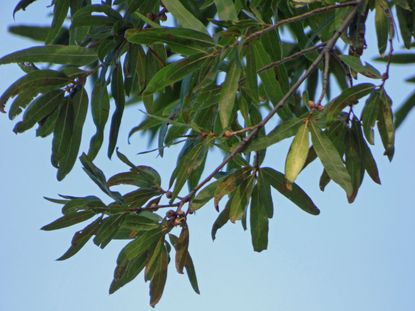Facts About Willow Oak Trees – Willow Oak Tree Pros And Cons


Willow oaks are no relation to willows but they seem to soak up water in a similar fashion. Where do willow oak trees grow? They thrive in floodplains and near streams or marshes, but the trees are remarkably drought tolerant, too. One of the interesting facts about willow oak trees is their relation to red oaks. They are in the red oak group but do not have the characteristic lobed leaves of the red oaks. Instead, willow oaks have narrow willow-like leaves with a bristle-like hair at the end of the foliage that characterizes them as oaks.
Willow Oak Tree Information
Willow oaks (Quercus phellos) are popular shade trees in parks and along streets. This tree grows fairly quickly and can become too large for some urban settings. The plant tolerates pollution and drought and has no serious insect or pest problems. The main factors for good willow oak tree care are water at establishment and some support when young. Willow oaks develop nicely symmetrical pyramid to round crown shapes. These attractive trees can grow up to 120 feet (37 m.) in height but are more commonly found at 60 to 70 feet (18-21 m.). The root zone is shallow, which makes it easy to transplant. The delicate leaves create dappled shade and produce a golden yellow color show in fall before they drop. Leaves are 2 to 8 inches (5-23 cm.) long, simple and entire. Willow oaks produce small acorns of ½ to 1 inch (1-3 cm.) in length. It takes 2 years for these to mature, which is a unique bit of willow oak tree information. These are very attractive to squirrels, chipmunks and other ground foragers. You can consider this one of willow oak trees pros, and also cons where ground litter is concerned.
Where Do Willow Oak Trees Grow?
Willow oaks are found from New York south to Florida and west to Texas, Oklahoma and Missouri. They occur in flood lands, alluvial plains, moist forest, stream banks and bottomlands. The plant thrives in moist acidic soils of almost any type. Willow oaks require full sun. In partial shade situations, the crown will develop into a weakly branched slender form as limbs reach for the sun. In full sun, the plant spreads out its limbs and makes a more balanced shape. For this reason, pruning young trees in low light is part of good willow oak care. Training early helps the tree form a strong structure.
Willow Oak Tree Pros and Cons
As a shade specimen in large public spaces, willow oak really can’t be beat for beauty and ease of management. But one of the facts about willow oak trees is their high water needs, especially when young. This can mean the tree will pirate moisture from other plants in the area. It is also a fast grower and can suck the local nutrients out of the soil as fast as they can be replaced. None of this is good for nearby flora. The dropped leaves in fall and acorns on the ground may be considered a nuisance. The animals attracted by the nuts are either cute to watch or annoying rodents. Additionally, the tree's large size may not be appropriate for the home landscape, and some of the tree’s peculiarities may be more than you are prepared to live with. Either way you look at it, willow oak is definitely a strong, versatile tree with good wind resistance and ease of care; just make sure it’s the right tree for your garden/landscape space.
Gardening tips, videos, info and more delivered right to your inbox!
Sign up for the Gardening Know How newsletter today and receive a free download of our most popular eBook "How to Grow Delicious Tomatoes."

Bonnie Grant is a professional landscaper with a Certification in Urban Gardening. She has been gardening and writing for 15 years. A former professional chef, she has a passion for edible landscaping.
-
 Monkey Orchid Care: How To Grow This Fascinating Species
Monkey Orchid Care: How To Grow This Fascinating SpeciesThe monkey orchid bears a remarkable resemblance to its namesake and, with a little know-how, can be successfully grown as a houseplant.
By Bonnie L. Grant
-
 How To Grow Garden To Table: A Guide For Home Cooks
How To Grow Garden To Table: A Guide For Home CooksWhat could be better than a meal that comes directly from garden to table? Show off your gardening and culinary skills with the very freshest food.
By Bonnie L. Grant